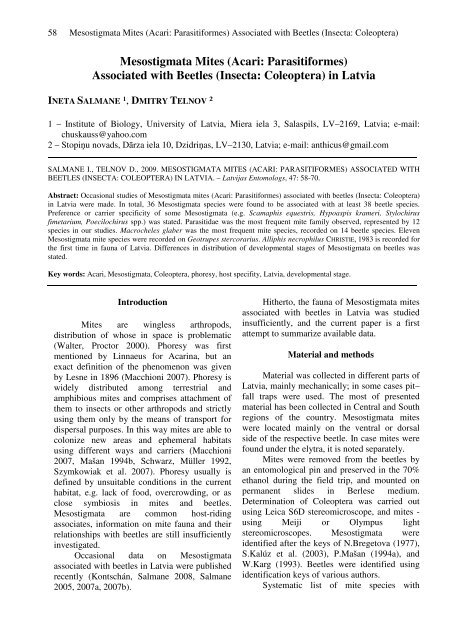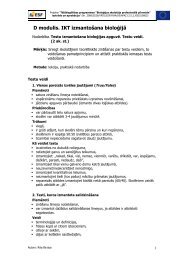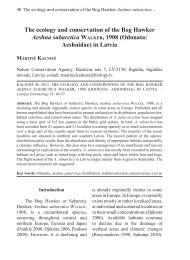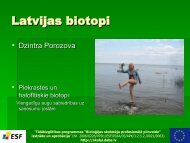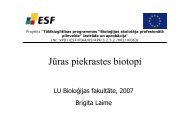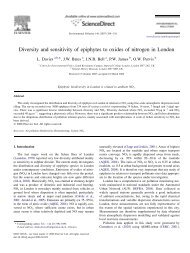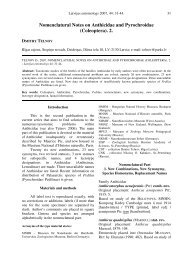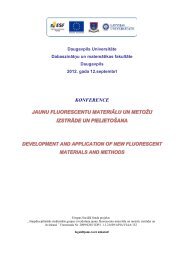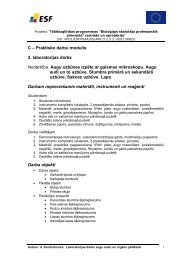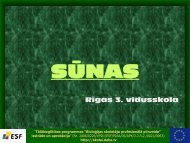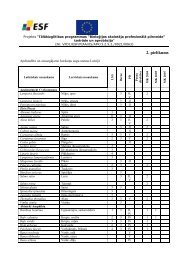Mesostigmata Mites (Acari: Parasitiformes) - Entomological Society ...
Mesostigmata Mites (Acari: Parasitiformes) - Entomological Society ...
Mesostigmata Mites (Acari: Parasitiformes) - Entomological Society ...
- No tags were found...
You also want an ePaper? Increase the reach of your titles
YUMPU automatically turns print PDFs into web optimized ePapers that Google loves.
58<strong>Mesostigmata</strong> <strong>Mites</strong> (<strong>Acari</strong>: <strong>Parasitiformes</strong>) Associated with Beetles (Insecta: Coleoptera)<strong>Mesostigmata</strong> <strong>Mites</strong> (<strong>Acari</strong>: <strong>Parasitiformes</strong>)Associated with Beetles (Insecta: Coleoptera) in LatviaINETA SALMANE ¹, DMITRY TELNOV ²1 – Institute of Biology, University of Latvia, Miera iela 3, Salaspils, LV–2169, Latvia; e-mail:chuskauss@yahoo.com2 – Stopiņu novads, Dārza iela 10, Dzidriņas, LV–2130, Latvia; e-mail: anthicus@gmail.comSALMANE I., TELNOV D., 2009. MESOSTIGMATA MITES (ACARI: PARASITIFORMES) ASSOCIATED WITHBEETLES (INSECTA: COLEOPTERA) IN LATVIA. – Latvijas Entomologs, 47: 58-70.Abstract: Occasional studies of <strong>Mesostigmata</strong> mites (<strong>Acari</strong>: <strong>Parasitiformes</strong>) associated with beetles (Insecta: Coleoptera)in Latvia were made. In total, 36 <strong>Mesostigmata</strong> species were found to be associated with at least 38 beetle species.Preference or carrier specificity of some <strong>Mesostigmata</strong> (e.g. Scamaphis equestris, Hypoaspis krameri, Stylochirusfimetarium, Poecilochirus spp.) was stated. Parasitidae was the most frequent mite family observed, represented by 12species in our studies. Macrocheles glaber was the most frequent mite species, recorded on 14 beetle species. Eleven<strong>Mesostigmata</strong> mite species were recorded on Geotrupes stercorarius. Alliphis necrophilus CHRISTIE, 1983 is recorded forthe first time in fauna of Latvia. Differences in distribution of developmental stages of <strong>Mesostigmata</strong> on beetles wasstated.Key words: <strong>Acari</strong>, <strong>Mesostigmata</strong>, Coleoptera, phoresy, host specifity, Latvia, developmental stage.Introduction<strong>Mites</strong> are wingless arthropods,distribution of whose in space is problematic(Walter, Proctor 2000). Phoresy was firstmentioned by Linnaeus for <strong>Acari</strong>na, but anexact definition of the phenomenon was givenby Lesne in 1896 (Macchioni 2007). Phoresy iswidely distributed among terrestrial andamphibious mites and comprises attachment ofthem to insects or other arthropods and strictlyusing them only by the means of transport fordispersal purposes. In this way mites are able tocolonize new areas and ephemeral habitatsusing different ways and carriers (Macchioni2007, Mašan 1994b, Schwarz, Müller 1992,Szymkowiak et al. 2007). Phoresy usually isdefined by unsuitable conditions in the currenthabitat, e.g. lack of food, overcrowding, or asclose symbiosis in mites and beetles.<strong>Mesostigmata</strong> are common host-ridingassociates, information on mite fauna and theirrelationships with beetles are still insufficientlyinvestigated.Occasional data on <strong>Mesostigmata</strong>associated with beetles in Latvia were publishedrecently (Kontschán, Salmane 2008, Salmane2005, 2007a, 2007b).Hitherto, the fauna of <strong>Mesostigmata</strong> mitesassociated with beetles in Latvia was studiedinsufficiently, and the current paper is a firstattempt to summarize available data.Material and methodsMaterial was collected in different parts ofLatvia, mainly mechanically; in some cases pit–fall traps were used. The most of presentedmaterial has been collected in Central and Southregions of the country. <strong>Mesostigmata</strong> miteswere located mainly on the ventral or dorsalside of the respective beetle. In case mites werefound under the elytra, it is noted separately.<strong>Mites</strong> were removed from the beetles byan entomological pin and preserved in the 70%ethanol during the field trip, and mounted onpermanent slides in Berlese medium.Determination of Coleoptera was carried outusing Leica S6D stereomicroscope, and mites -using Meiji or Olympus lightstereomicroscopes. <strong>Mesostigmata</strong> wereidentified after the keys of N.Bregetova (1977),S.Kalúz et al. (2003), P.Mašan (1994a), andW.Karg (1993). Beetles were identified usingidentification keys of various authors.Systematic list of mite species with
Latvijas Entomologs 2009, 47: 58-70. 59collecting locality information is presented.Hosts are arranged alphabetically by theirfamilies and genera in the list, as well as in thetable 1.Explanations and abbreviations used in the text: DN –deuteronypmh, DP – nature park, F – female, f. – forest,g. – garden, HPS – Hydroelectric Power Station, IB –Institute of Biology, University of Latvia, l. – lake, LEM– Latvian Ethnographical Open–Air Museum, M – male,m. – municipality, NBR – North Vidzeme Biospherereserve, NP – National Park, pa. – park, p. – pond, r. –river, vill. – village or small settlement, * - new species tothe fauna of Latvia. Some of the abbreviations employedare not standard English language abbreviations.List of <strong>Mesostigmata</strong> speciesassociated with beetles in LatviaMicrogyniidae TRÄGARDH, 1942Microsejus truncicola TRÄGARDH, 1942Material: Dictyoptera aurora (HERBST, 1784)(Lycidae) – (Salmane 2005).Microgynium rectangulatum TRÄGARDH, 1942Material: Hylurgops palliatus (GYLLENHAL,1813) (Scolytidae) – (Salmane 2007b).Diplogyniidae TRÄGARDH, 1941Loboginoides spelaea WILLMANN, 1941Material: Uloma rufa (PILLER, MITTERPACHER,1783) (Tenebrionidae) – (Salmane 2005,2007b).Parasitidae OUDEMANS, 1901Parasitus fimetorum BERLESE, 1903Material: Pterostichus nigrita nigrita(PAYKULL, 1790) (Carabidae) – Limbaži m.,Lēdurga dendrological pa., 11.05.2002 (2 DN),leg. I.Salmane; Hister bissexstriatus FABRICIUS,1801 (Histeridae) – Ogre m., Ogre, Špakovskapa., 17.04.2004 (1 DN), leg. I.Salmane;Histeridae gen. sp. – Ogre m., Ogre, Pagasta iela8, g., 07.07.2003 (1 F), leg. I.Salmane;Platycerus caraboides caraboides (LINNAEUS,1758) (Lucanidae) – Ogre m., Ogre, Špakovskapa., 17.04.2004 (6 DN), leg. I.Salmane.Parasitus lunaris BERLESE, 1906Material: Silphidae gen. sp. – Ogre m., Ogre,Pagasta iela 8, g., 20.06.2003 (1 DN), leg.I.Salmane.Parasitus fucorum (DEGEER, 1778)Material: Coleoptera fam. indet. – (Lapiņa 1988,Salmane 2001).Parasitus copridis COSTA, 1963Material: Geotrupes stercorarius (LINNAEUS,1758) (Geotrupidae) – (Salmane 2005); Tukumsm., Engure DP, near ornithological station at l.Engures, 10.09.2005 (2 DN), leg. I.Salmane;Aphodius sordidus (FABRICIUS, 1775)(Scarabaeidae) – Liepāja m., Pape DP, near l.Liepājas, meadow, horse dung, 17.06.2005 (1DN), leg. D.Telnov.Parasitus celer (C.L.KOCH, 1835)Material: Carabidae gen. sp. – Gulbene m.,Velēna surroundings, 20.08.1972 (2 DN), leg.,det. I.Lapiņa; Anoplotrupes stercorosus(L.G.SCRIBA, 1791) (Geotrupidae) – Rīga m.,Piejūras DP, between Garupe and Carnikava,coastal pine f., 08.10.2005 (1 DN), leg.I.Salmane; Geotrupes stercorarius (LINNAEUS,1758) (Geotrupidae) – Cēsis m., Gauja NP,Cēsis, mixed f. near Benča atteka (oxbow),18.08.2004 (1 DN), coniferous f. near Mežakapi (graveyard), 18.08.2004 (2 DN), leg.I.Salmane; Limbaži m., near Meleki vill.,coastal pine f., 21.08.2003 (1 DN), leg.I.Salmane; Ogre m., Ogre, Pārogre, near Rīga-Daugavpils highway, 04.05.2004 (4 DN),Špakovska pa., 15.10.2004 (3 DN), Ikšķilecountry territory between Ogres kapi(graveyard) and Lībieškalns, spruce f.,17.05.2009 (5 DN), Tome surroundings,coniferous f., 19.08-06.09.2009, (7 DN), leg.R.Spots; Rīga m., Jūrmala, Melluži, mixed f.,2.10.2004 (2 DN), leg. I.Salmane; Talsi m.,Slītere NP, Kolkasrags (Kolka cape) coastalpine f., 01.08.2005 (1 DN), leg. I.Salmane;Tukums m., Engure DP, near ornithologicalstation at l. Engures, 10.09.2005 (13 DN), leg.I.Salmane; Geotrupes sp. (Geotrupidae) – Ogrem., Ogre, mixed f., 14.08.1998 (27 DN), leg.I.Salmane; Margarinotus sp. (Histeridae) –Ogre m., Ogre, Pagasta iela 8, g., 23.05.2005 (1DN), leg. I.Salmane; Histeridae gen. sp. – Rīgam., Gauja NP, Turaida, mixed f., 12.07.2003 (1DN), leg. I.Salmane; Ogre m., Ogre, Špakovskapa., 01.05.2004 (1 DN), leg. I.Salmane; Pagastaiela 8, g., 11.06.2004 (6 DN), 19.06.2004 (1 F, 5DN), leg. I.Salmane; Aphodius sordidus
62<strong>Mesostigmata</strong> <strong>Mites</strong> (<strong>Acari</strong>: <strong>Parasitiformes</strong>) Associated with Beetles (Insecta: Coleoptera)I.Salmane; Geotrupes sp. (Geotrupidae) – Cēsism., Taurene, coniferous f. near Lodes muiža(manor), 26.09.1998 (1 F), leg. I.Salmane; Ogrem., Zilie kalni (hills), spruce f., 19.10.1997 (12F), Ogre, Pārogre, mixed f., 14.08.1998 (4 F),leg. I.Salmane; Rīga m., Ropaži, mixed f.,09.09.1998 (2 F), Cekule vill., mixed f.,13.08.2002 (55), leg. I.Salmane; Histeridae gen.sp. – Ogre m., Ogre, Pagasta iela 8, g.,07.07.2003 (9 F), 11.06.2004 (22 F), 19.06.2004(2 F), leg. I.Salmane; Aphodius fossor(LINNAEUS, 1758) (Scarabaeidae) – Ogre m.,Ogre, Pārogre, mixed f., 26.07.2001 (3 F), leg.I.Salmane; Aphodius sordidus (FABRICIUS,1775) (Scarabaeidae) – Liepāja m., near l.Liepājas, meadow, horse dung, 17.06.2005 (4F), leg. D.Telnov; Oryctes nasicornis nasicornis(LINNAEUS, 1758) (Scarabaeidae) – Ogre m.,Ogre, Pagasta iela 8, g., compost, 18.07.2006 (2F), leg. I.Salmane; Scarabaeidae gen. sp. – Ogrem., Ogre, Pagasta iela 8, g., 25.05.2001 (2 F),29.06.2003 (2 F), leg. I.Salmane; Talsi m.,Slītere NP, Kolkasrags (Kolka cape), coastalpine f., 17.07.2001 (4 F), 22.07.2003 (8 F),Kolka surroundings, bushes near p. Zēņu,19.07.2003 (3 F), 23.07.2003 (1 F), leg.I.Salmane; Valmiera m., Mazsalaca, pine f. nearSkaņais kalns (hill), 30.08.2000 (5 F),26.08.2003 (1 F), leg. I.Salmane; Trypodendronlaeve EGGERS, 1939 (Scolytidae) – Ogre m.,Ogre, Pagasta iela 8, g., 23.09.2007 (1 F), leg.I.Salmane; Nicrophorus vespillo (LINNAEUS,1758) (Silphidae) – Ogre m., Ogre, Pārogre,mixed f., 08.09.2002 (2 F), leg. I.Salmane;Nicrophorus vespilloides HERBST, 1783(Silphidae) – Cēsis m., Taurene, deciduous f.near Lodes muiža (manor), 15.06.2001 (28 F),leg. I.Salmane; Oiceoptoma thoracica thoracica(LINNAEUS, 1758) (Silphidae) – Ogre m., Ogre,Pagasta iela 8, g., 15.06.2004 (69 F), Lašupessurroundings, close to the city limit near r. Ogre,on grass, 25.07.2009 (2 F), leg. I.Salmane;Silphidae gen. sp. – Ogre m., Ogre, Pagasta iela8, g., 20.06.2003 (1 F), leg. I.Salmane.Macrocheles perglaber FILIPPONI etPEGAZZANO, 1962Material: Geotrupes stercorarius (LINNAEUS,1758) (Geotrupidae) – (Salmane 2005).Ologamasidae RYKE, 1962Stylochirus fimetarium (J.MÜLLER, 1859)[according to Mašan, Kalúz, 2001]Material: Carabus cancellatus cancellatusILLIGER, 1798 (Carabidae) – Ogre m., Ogre,Pārogre, mixed f., 24.03.2002 (7 DN),08.09.2002 (1 DN), leg. I.Salmane; Rīga m.,Cekule vill. surroundings, mixed f., 13.08.2002(14 DN), leg. D.Telnov; Carabus coriaceuscoriaceus LINNAEUS, 1758 (Carabidae) – Cēsism., Gauja NP, Skaļupes, mixed f., 11.07.2003 (3DN), leg. I.Salmane; Rīga m., Cekule vill.surroundings, mixed f., 13.08.2002 (1 DN), leg.D.Telnov; Carabus glabratus glabratusPAYKULL, 1790 (Carabidae) – Cēsis m., GaujaNP, Skaļupes, mixed f., 11.07.2003 (3 DN),near r. Mergupe, close to Nītaure, mixed f.,01.08.2003 (1 DN), leg. I.Salmane; Carabusnemoralis nemoralis O.F.MÜLLER, 1764(Carabidae) – Bauska m., near Mežotnespilskalns (hillfort), broadleaved f., 4.05.2006 (4F), leg. I.Salmane; Ogre m., Ogre, Pārogre,mixed f., 08.09.2002 (10 DN), on road inPārogre railway station surroundings,27.07.2009 (2 DN); leg. I.Salmane; Cychruscaraboides (LINNAEUS, 1758) (Carabidae) –Rīga m., Cekule vill. surroundings, pine/birch f.,13.04.2002 (1 DN), leg. D.Telnov, Gauja NP,Sigulda, mixed f. near r. Gauja, 06.08.2002 (9DN), leg. I.Salmane; Pterostichus aethiops(PANZER, 1796) (Carabidae) – Rīga m., PiejūrasDP, between Garupe and Carnikava, coastalpine f., 8.10.2005 (1 DN), leg. I.Salmane;Pterostichus niger niger (SCHALLER, 1783)(Carabidae) – Liepāja m., Embūte surroundings,Embūte DP, broadleaved f., on beetles understone, 18.07.2009 (6 DN), leg. D.Telnov;Limbaži m., Lēdurga, dendrological pa.,11.05.2003 (1 DN), leg. I.Salmane; Ogre m.,Ogre, Pārogre, mixed f., 24.03.2002 (10 DN),08.09.2002 (2 DN, under elytra), leg. I.Salmane;Rīga m., Carnikava surroundings, 20.04.2002 (1DN), leg. D.Telnov; Pterostichus nigrita(PAYKULL, 1790) (Carabidae) – Ogre m., Ogre,Pārogre, mixed f., 08.09.2002 (29 DN), leg.I.Salmane; Rīga m., Cekule vill. surroundings,mixed f., 13.08.2002 (2 DN), leg. D.Telnov,Gauja NP, Sigulda, mixed f. near r. Gauja,06.08.2002 (5 DN), Gauja vill. surroundings,coastal pine f., 05.09.2002 (10 DN, underelytra), leg. I.Salmane; Pterostichus
Latvijas Entomologs 2009, 47: 58-70. 63oblongopunctatusoblongopunctatus(FABRICIUS, 1787) (Carabidae) – Rīga m., GaujaNP, Sigulda, mixed f. near r. Gauja, 06.08.2002(1 DN), Piejūras DP, Lilaste, mixed f. near l.Ziemeļu Garezers, 05.09.2002 (2 DN), leg.I.Salmane; Carabidae gen. sp. – Ogre m., Ziliekalni (hills), spruce f., 19.10.1997 (11 DN), leg.I.Salmane; Geotrupes stercorarius (LINNAEUS,1758) (Geotrupidae) – Alūksne m., Māriņkalns,mixed f., 09.08.2003 (2 DN), leg. I.Salmane;Cēsis m., Cēsis, Pārgauja, mixed f., 18.07.2004(1 DN), leg. I.Salmane; Ogre m., Ogre,Špakovska pa., 15.10.2004 (4 DN, under elytra),leg. I.Salmane; Tukums m., ornithologicalstation near l. Engures, 11.09.2004 (3 DN), leg.I.Salmane.Stylochirus physogastris KARG, 1971 [sensuMašan, Kalúz, 2001]Material: Carabidae gen. sp. – Ogre m., Ogre,Pārogre, mixed f., 05.07.2003 (1 DN), leg.I.Salmane.Laelaptidae BERLESE, 1892Hypoaspis krameri (G.CANESTRINI etR.CANESTRINI, 1881)Material: Oryctes nasicornis nasicornis(LINNAEUS, 1758) (Scarabaeidae) – Ogre m.,Ogre, Pagasta iela 8, g., compost, 6.07.2005 (9F), 18.07.2006 (2 F), leg. I.Salmane; Rīga m.,Langstiņi vill., g., 09.06.1997 (15 F), leg.V.Melecis, Olaine, compost, 05.08.1998 (10 F),Salaspils, territory of IB, 17.07.2004 (10 F), leg.I.Salmane; Talsi m., Slītere NP, Kolkasurroundings, sawdust, 20.07.2001 (24 F), leg.I.Salmane.Hypoaspis lubricoides KARG, 1971Material: Hylurgops palliatus (GYLLENHAL,1813) (Scolytidae) – (Salmane 2007b).Eviphidae BERLESE, 1913Scarabaspis inexpectatus OUDEMANS, 1903Material: Geotrupes stercorarius (LINNAEUS,1758) (Geotrupidae) – (Salmane 2005);Aphodius fossor (LINNAEUS, 1758)(Scarabaeidae) – Rīga m., Tumšupe vill. env.,along the road to Garkalne, meadow, cow dung,24.05.2003 (3 F, 1 DN), leg. D.Telnov;Aphodius sordidus (FABRICIUS, 1775)(Scarabaeidae) – Liepāja m., near l. Liepājas,meadow, horse dung, 17.06.2005 (4 DN), leg.D.Telnov.Alliphis halleri (G.CANESTRINI etR.CANESTRINI, 1881)Material: Carabidae gen. sp. – Ogre m., Ziliekalni (hills), spruce f., 19.10.1997 (1 F), leg.I.Salmane; Coleoptera fam. indet. – (Lapiņa1988, Salmane 2001); Anoplotrupes stercorosus(L.G.SCRIBA, 1791) (Geotrupidae) – Rīga m.,Piejūras DP, between Garupe and Carnikava,coastal pine f., 8.10.2005 (3 F), leg. I.Salmane;Talsi m., Slītere NP, Kolka, bushes near p.Zēņu, 22.07.2002 (1 F), leg. I.Salmane;Carabidae gen. sp. – Ogre m., Zilie kalni (hills),spruce f., 19.10.1997 (1), leg. I.Salmane;Geotrupes stercorarius (LINNAEUS, 1758)(Geotrupidae) – Cēsis m., Cēsis, Pārgauja,mixed f., 18.07.2004 (1 F), Benča atteka(oxbow), mixed f., 18.08.2004 (2 F), coniferousf., 18.08.2004 (3 F), leg. I.Salmane; Limbaži m.,coastal pine f. near Meleki, 21.08.2003 (11 F),leg. I.Salmane; Rīga m., Cekule vill.surroundings, mixed f., 13.08.2002 (25 F, 9 M,9 DN), Rīga, LEM, horse dung, 19.08.2004 (3F, under elytra), leg. I.Salmane; Talsi m., SlītereNP, Kolkasrags (Kolka cape), coastal pine f.,06.08.2004 (5 F), 1.08.2005 (1 F), leg.I.Salmane; Tukums m., ornithological stationnear l. Engures, 11.09.2004 (5), 10.09.2005 (15F), leg. I.Salmane; Geotrupes sp. (Geotrupidae)– Rīga m., Cekule vill. surroundings, mixed f.,13.08.2002 (58), leg. D.Telnov, Ropaži, pine f.,09.09.1998 (8 F, 1 M), leg. I.Salmane;Histeridae gen. sp. – Ogre m., Ogre, Pagasta iela8, g., 07.07.2003 (1 DN), leg. I.Salmane; Rīgam., Gauja NP, Turaida, mixed f., 12.07.2003 (2DN), leg. I.Salmane; Scarabaeidae gen. sp. –Talsi m., Slītere NP, Kolkasrags (Kolka cape),coastal pine f., 18.07.2003 (1 M, 2 DN),22.07.2003 (3 DN), Kolka surroundings,grassland near p. Zēņu, 19.07.2003 (2 F, 3 M, 6DN), bushes near p. Zēņu, 23.07.2003 (2 DN),leg. I.Salmane; Valmiera m., Mazsalaca, pine f.near Skaņais kalns (hill), 30.08.2000 (4 F, 1DN), leg. I.Salmane.*Alliphis necrophilus CHRISTIE, 1983Material: Aphodius prodromus (BRAHM, 1790)(Scarabaeidae) – Rīga, central railway terminal,train platform, 22.04.2009 (1 F), leg. I.Salmane.
64<strong>Mesostigmata</strong> <strong>Mites</strong> (<strong>Acari</strong>: <strong>Parasitiformes</strong>) Associated with Beetles (Insecta: Coleoptera)Scamaphis equestris (BERLESE, 1911)Material: Geotrupes stercorarius (LINNAEUS,1758) (Geotrupidae) – (Salmane 2005).Trematuridae BERLESE, 1917 (KARG, 1989)Trichouropoda ovalis (C.L.KOCH, 1839)Material: Histeridae gen. sp. – Ogre m., Ogre,Pagasta iela 8, g., compost, 11.06.2004, leg.I.Salmane.Uropodidae KRÄMER, 1881Uropoda ocellata KONTSCHÁN et SALMANE,2008Material: Histeridae gen. sp. – (Kontschán,Salmane 2008).Uropodina spp.Material: Pterostichus nigrita nigrita(PAYKULL, 1790) (Carabidae) – Limbaži m.,Lēdurga, dendrological pa., 11.05.2003, leg.I.Salmane; Cantharidae gen. sp. – Cēsis m., nearl. Talejas, 7.06.2003, leg. I.Salmane;Curculionidae gen. sp. – Cēsis m., Taurenesurroundings near Lodes muiža (manor),meadow, 10.06.1998, leg. I.Salmane;Prosternon tessellatum (LINNAEUS, 1758)(Elateridae) – Rīga m., Lilaste, near l. Garezers,deciduous f., 4.06.2006, leg. I.Salmane;Elateridae gen. sp. – Ogre m., Ogre, Pārogre,mixed f., 18.05.2003, leg. I.Salmane; Atholuscorvinus (GERMAR, 1817) (Histeridae) – Rīgam., Salaspils, National Botanical garden,30.04.2002, leg. D.Telnov; Hister unicolorLINNAEUS, 1758 (Histeridae) – Ogre m., Vērenevill. surroundings, cow dung, 24.05.2003, leg.D.Telnov; Histeridae gen. sp. – Cēsis m.,Taurene surroundings near Lodes muiža(manor), cow dung, 6.06.2003, leg. I.Salmane;Ogre m., Ogre, Pagasta iela 8, g., compost,04.05.2003, 25.05–1.06.2003, leg. I.Salmane;Aphodius fimetarius (LINNAEUS, 1758)(Scarabaeidae) – Cēsis m., Taurenesurroundings near Lodes muiža (manor), cowdung, 06.06.2003, leg. I.Salmane; Rīga m.,Cekule vill. surroundings, 10.05.2003, leg.D.Telnov; Aphodius prodromus (BRAHM, 1790)(Scarabaeidae) – Ogre m., Ogre, Pagasta iela 8,sidewalk, 02.05.2008, leg. I.Salmane;Onthophagus nuchicornis (LINNAEUS, 1758)(Scarabaeidae) – Ogre m., Ogre, Pagasta iela 8,g., 23.09.2007, leg. I.Salmane; Oryctesnasicornis nasicornis (LINNAEUS, 1758)(Scarabaeidae) – Ogre m., Ogre, Pagasta iela 8,g., compost, 18.07.2006, leg. I.Salmane;Scarabaeidae gen. sp. – Ogre m., Ogre, Ogressala, bushes, 06.05.2003, leg. I.Salmane;Trypodendron laeve EGGERS, 1939 (Scolytidae)– Ogre m., Ogre, Pagasta iela 8, g., 23.09.2007,leg. I.Salmane; Scolytidae gen. sp. – Ogre m.,Ogre, Pagasta iela 8, g., 28.04.2007, leg.I.Salmane; Ocypus ophthalmicus ophthalmicus(SCOPOLI, 1763) (Staphylinidae) – Ogre m.,Ogre, Pagasta iela 8, g., 25.05.2003, leg.I.Salmane.DiscussionThirty eight species were identified amongthe collected beetles; the rest of themdetermined to the genus or family level (Table1). Of the mites, 36 <strong>Mesostigmata</strong> species wereidentified, of them Parasitidae - 12 species,Eviphidae - 4, Ologamasidae - 2, Microgyniidae- 2, Macrochelidae - 2 species, and the rest offamilies represented by single species each.Deuteronymphs of the genera Poecilochirus andsome of Dendrolaelaps, as well as material ofsuborder Uropodina (with exception ofTrichouropada ovalis and Uropoda ocellata)was not identified to the species level. Speciesof the genus Iphidosoma BERLESE, 1892 after P.Mašan, S. Kalúz (2001) are synonymies of thegenus Stylochirus G.CANESTRIN etR.CANESTRINI, 1882 and are placed in thefamily Ologamasidae RYKE, 1962 (after N.Bregetova 1977, P. Mašan, pers. comm.).The most diverse mite fauna was found onScarabaeidae and Geotrupidae beetles: 14 mitespecies were recorded, with 6 speciesdominating (Table 1). High number of species(16) was recorded from Geotrupes sensu latobeetles in Slovakia (Mašan 1994b). OnScarabaeidae and Geotrupidae beetles mainlymites of the families Parasitidae,Macrochelidae, Eviphidae and Uropodina werefound (Table 1). Similar observations weremade in Japan (Takaku et al. 1994), where themost abundant mite fauna (Macrochelidae,Evipihidae) was found on Scarabaeidae beetles.Development of those mites – trophical orreproductive, or both – in some way are related
Latvijas Entomologs 2009, 47: 58-70. 65to the animal dung. Unfortunately, Uropodinamaterial was not identified, and it is impossibleto comment species diversity of this group now.Still, the most numerously in our investigationthey were found on Aphodius spp.(Scarabaeidae).Among investigated Scarabaeidae andGeotrupidae beetles, the most diverse fauna ofmites (10 species) was recorded on Geotrupesstercorarius, which is the commonest species ofGeotrupidae family in the Baltic region. Ofmesostigmatids 61,7 % was Macrochelesglaber, 21,7 % - Alliphis halleri and 7,8 % -Parasitus celer. M. glaber was also the mostnumerously found on Scarabaeidae beetlesduring investigations made in Russia andSlovakia (Makarova 1995, Mašan 1995). It wasrecorded on 14 beetle species, mainly onScarabaeidae, Geotrupidae and Silphidae. Suchkind of distribution of this mite is related to itslife history strategy. As known, beside of manyother small invertebrates, Macrocheles mites arethe main predators of dipteran eggs and larvae,which are abundantly presented as in animalexcrements, as well as on dead animal corpses,and which are the main concurrents ofScarabaeidae and Silphidae beetle larvae forfood resources and development of new beetlegenerations (Krantz 1983, Niogret et al. 2006,2007, M.M.H.Wallace et al.1979). M. glaberhas a World-wide distribution and phoretic habiton beetles (Niogret et al. 2006). Mite species P.celer was recorded on Scarabaeidae beetles alsoin Germany and Hungary (Karg, Rossner 1999).Three <strong>Mesostigmata</strong> species were foundon Oryctes nasicornis. Of them 88,6 % wasHypoaspis krameri, 8,9 % - Parasitus celer and2,5 % - Macrocheles glaber. H. krameri is awell known and specific phoretic mite associateof the genus Oryctes and stag-beetles(Lucanidae) in Europe (Bregetova 1977, Karg1993), development of which is closely relatedto the developmental substrate of beetle larvae.Eight mite species were recorded onCarabidae beetles (Table 1). Prevalence ofPoecilochirus necrophori and Stylochirusfimetarius on them was obvious. Similar resultsare shown in the investigations carried out by L.Lundquist (1991) in southern Sweden. Werecorded S. fimetarius also on Geotrupesstercorarius in three cases, but otherwise it wasquite specific to carabid beetles – it wasrecorded on 10 Carabidae species. In addition,on Pterostichus niger and Cychrus caraboidesS. fimetarius was found in 100 % of mitespecimens found on this beetle. On Pterostichusnigrita it was 81,0 % of mite specimen number,and on Carabus nemoralis and Carabuscancellatus 69,6 % and 59,5 %, respectively.Investigations made in Japan (Takaku et al.1994) reviled two mite species on Carabidae,one identical to our S. fimetarius (distributed inEurope and Asia Minor (Bregetova 1977, Karg1993)), and other one - Poecilochirus carabi(distributed in Palaearctic (Bregetova 1977,Karg 1993)). As it is confirmed by otherinvestigations, S. fimetarius is a phoretic speciesmainly on Carabidae beetles (Makarova 1995).Eight mite species were recorded onSilphidae species. Poecilochirus necrophori, P.subterraneus, and P. davydovae are typicalsymbionts, because these are well-knownrelationships and interdependence amongNicrophorus beetles and Poecilochirus mites(Schwarz, Koulianos 1998, Schwarz, Müller1992, Springett 1968). On Nicrophorus vespillobeetles P. necrophori was 73,1 % of recordedmites and P. davydovae 12,2 %. On Oiceoptomathoracica were recorded five mite species; 72 %of them were M. glaber, 15 % Parasitus celerand 11 % P. necrophori. The last species wasrecorded on 13 beetle species, mainly Silphidaeand Carabidae.Eight mite species were found onHisteridae beetles. The Uropodina mites werethe dominating, of them only Trichouropadaovalis was identified to the species level.Uropoda ocellata was recently described as newfor science species from Histeridae gen. sp.beetle collected in Central Latvia (Kontschán,Salmane 2008).According to results of our investigations,some recorded mesostigmatid species werefound carrier specific: Scamaphis equestris wasrestricted to G. stercorarius. It was found onother species of genus Geotrupes as well(Haitlinger 1990, Hyatt 1956, Mašan 1994b).Hypoaspis krameri was restricted to Oryctesnasicornis. Scarabaspis inexpectatus wasrecorded only on Scarabaeidae and Geotrupidaebeetles. Stylochirus fimetarius was collectedmainly from ground-beetles (Carabidae), and
66<strong>Mesostigmata</strong> <strong>Mites</strong> (<strong>Acari</strong>: <strong>Parasitiformes</strong>) Associated with Beetles (Insecta: Coleoptera)Poecilochirus subterraneus and P. davydovaeonly from Silphidae beetles.Occurrence of Microsejus truncicola,Microgynium rectangulatum, and Loboginoidesspelaea mites is restricted to wood-relatedbeetles. These species are common inhabitantsof decaying wood and also are recorded onwood inhabiting beetles (Bregetova 1977).Species Alliphis necrophilus (Eviphidae)was recorded for the first time in Latvia and wasfound phoretic on Aphodius prodromus(Geotrupidae). Hitherto, this species wascollected from Nicrophorus beetles only (Mašan1994a, 1999, Takaku et al. 1994).Parasitus lunaris, Parasitus lunulatus,Parasitus kraepelini and Cheiroseiusnecorniger were recorded on the beetlesaccidentally and in low numbers.Specific occurrence of variousdevelopmental stages of <strong>Mesostigmata</strong> mites onbeetles was stated. Phoretic deuteronymphs,females and males were stated within familiesEviphidae, Aceosejidae, Rhodacaridae andSchizosthetus simulatrix (Parasitidae). Thesimilar data for family Eviphidae were found byP.Mašan (1999). Only adult phoretic stageswere found for Ameroseiidae, Laelaptidae andMacrochelidae, in addition, only females wererecorded of two last families. The similarobservations were made by L.Lundquist (1998)and P.Mašan (1999). Dispersal of Macrochelesmites is accomplished by the females (Evans etal. 1961). For many phoretic <strong>Mesostigmata</strong>species their feeding habits are unknown, still itis assumed, that many of them during theirtravel on beetle are not feeding. There arerecords of Macrocheles glaber females, whichmay feed on scraps of food adhering to the setaein the region of mouthparts of the beetle (Evanset al. 1961). Of Parasitidae (with exception ofSchizosthetus simulatrix), Ologamasidae andUropodina as phoretic were recordeddeuteronymphs and in some cases also phoreticfemales. Parasitus (Parasitidae), Uropodidaeand Trichouropoda (Uropodina) usually havephoretic deuteronymphs (Evans et al. 1961,Krantz 1978). As well as deuteronymphs of thegenus Poecilochirus usually are phoretic; theydevelop in brood chambers of Nicrophorusbeetle’s larvae and attaches to the adult beetles(Schwarz 1991, Springett 1968). Observationshave been made on deuteronymphs ofPoecilochirus mites having adaptations ofchelicera, possibly, for stealing of food frommandibles of its host carrion beetle (Silphidae)(Lindquist 1975).AcknowledgmentsAuthors are grateful to P. Mašan (Instituteof Zoology, Slovak Academy of Sciences,Bratislava) for given help in determination ofsome mite species.ReferencesBregetova N.G. 1977. [Identification keys forsoil inhabiting mites. <strong>Mesostigmata</strong>].Nauka, Leningrad: 717 pp. (in Russian).Evans G.O., Sheals J.G., Macfarlane D. 1961.The terrestrial <strong>Acari</strong> of the British isles.An Introduction to their Morphology,Biology and Classification. Volume 1.Introduction and Biology. London,Trustees of the British Museum: 219 pp.Haitlinger R. 1990. <strong>Mites</strong> (<strong>Acari</strong>) occuring onGeotrupes vernalis (L. 1758) (Insecta,Scarabaeidae) in Poland. – WiadomosciParazytologiczne 36: 137-143.Hyatt K.E. 1956. Mesostigmatid mitesassociated with Geotrupes stercorarius(L.) (Coleoptera, Scarabaeidae). –Entomologist’s Monthly Magazine 95:22-23.Kalúz S., Mašán P., Moser J. 2003. Morphologyand ecology of Schizosthetus simulatrix(<strong>Acari</strong>, <strong>Mesostigmata</strong>) associated withgalleries of bark beetles (Scolytidae). –Biologia 58, No. 2: 165-172.Karg W. 1993. <strong>Acari</strong> (<strong>Acari</strong>na), Milben<strong>Parasitiformes</strong> (Anactinochaeta)Cochors Gamasina LEACH. Raubmilben.2., überarbeitete Auflage. Jena, Stuttgart,New York, Gustav Fischer: 524 pp.Karg W., Rossner E. 1999. Phoresie vonRaubmilben (Arachnida, <strong>Acari</strong>,Gamasina) mit paläarktischenBlatthornkäfern (Col., Scarabaeidae). –Entomologische Nachrichten undBerichte 43, No. 3/4: 224–227.Kontschán J., Salmane I. 2008. New records ofthe Uropodina mites of Latvia and
Latvijas Entomologs 2009, 47: 58-70. 67description of two new species (<strong>Acari</strong>:<strong>Mesostigmata</strong>). – Genus 19, No. 2: 335–341.Krantz G.W. 1978. Manual of Acarology.Oregon state university book stores, inc.Corvallis: 508 pp.Krantz G.W. 1983. <strong>Mites</strong> as biological controlagents of dung breeding-flies, withspecial reference to the Macrochelidae.In: Hoy M.A., Cunningham G.L. &Knutson L. (eds) Biological Control ofPests by <strong>Mites</strong>. University of California,Special Publication No. 3304: 91-98.Lapina I. 1988. Gamasin mites of Latvia.Zinātne, Rīga: 198 pp. (in Russian,English abstract).Lindquist E.E. 1975. Associations betweenmites and other arthropods in forest floorhabitats. – The Canadian Entomologist107: 425-437.Lundquist L. 1991. Rearing deutonymphs ofIphidosoma fimetarium (J. MÜLLER), amesostigmatic mite associated withcarabid beetles. In: Schuster, R. &Murphy, P.W. (eds) The <strong>Acari</strong>:Reproduction, Development and LifeHistory Strategies. Chapman Hall,London: 447–452.Lundquist L. 1998. Phoretic Gamasina (<strong>Acari</strong>)from Southern Sweden: taxonomy, hostpreferences and seasonality. –Acarologia 39, No. 2: 111-114.Macchioni F. 2007. Importance of phoresy inthe transmission of <strong>Acari</strong>. –Parasitologia 49: 17-22.Makarova O.L. 1995. [Mesostigmatic mites(<strong>Parasitiformes</strong>, <strong>Mesostigmata</strong>) on theforest dung beetle Geotrupesstercorosus]. – Journal of Zoology 75,No. 11: 16–23.Mašan P. 1994a. The Eviphid mites (<strong>Acari</strong>na:<strong>Mesostigmata</strong>: Eviphidae) associatedwith Scarabaeid and carrion beetles(Coleoptera: Scarabaeidae, Silphidae) inCentral Europe. – Acarologia 35, No. 1:3-19.Mašan P. 1994b. The mesostigmatic mites(<strong>Acari</strong>na, <strong>Mesostigmata</strong>) associated withthe dung beetles (Coleoptera,Scarabaeidae) in South Slovakia. –Biologia 49, No. 2: 201–205.Mašan P. 1995. The gamasoid mites (<strong>Acari</strong>na)associated with the scarabaeid andsilphid beetles (Coleoptera) in theprotected landscape area CerovaVrchovina MTS. – Li-NOX RimavskaSobota: 16-20.Mašan P. 1999. <strong>Mites</strong> (<strong>Acari</strong>na) associated withburying and carrion beetles (Coleoptera,Silphidae) and description ofPoecilochirus mrciaki sp. N.(<strong>Mesostigmata</strong>, Gamasina). – Biologia54, No. 5: 515-524.Mašan P., Kalúz S. 2001. The adult stages ofStylochirus fimetarius (<strong>Acari</strong>,<strong>Mesostigmata</strong>) and new systematicstatus of the genus Iphidosoma. –Biologia 56, No. 5: 483-488.Niogret J., Lumaret J.-P., Bertrand M. 2006.Review of the phoretic associationbetween coprophilous insects andmacrochelid mites (<strong>Acari</strong> :<strong>Mesostigmata</strong>). – Elytron 20: 99-121.Niogret J., Nicot A., Bertrand M. 2007. Twonew species of Macrocheles from France(<strong>Mesostigmata</strong>: Macrochelidae). –Acarologia 47, No. 3/4: 115-120.Salmane I. 2001. A check–list of LatvianGamasina mites (<strong>Acari</strong>, <strong>Mesostigmata</strong>)with short notes to their ecology. –Latvijas Entomologs 38: 27–39.Salmane I. 2005. Addition to the Latvian<strong>Mesostigmata</strong> (<strong>Acari</strong>, <strong>Parasitiformes</strong>)Check–list. – Latvijas Entomologs 42:72–76.Salmane I. 2006. New <strong>Mesostigmata</strong> (<strong>Acari</strong>,<strong>Parasitiformes</strong>) Species in the Fauna ofLatvia. – Latvijas Entomologs 43: 52-56.Salmane I. 2007a. New and Rare <strong>Mesostigmata</strong>mites (<strong>Acari</strong>, <strong>Parasitiformes</strong>) in Latvia. –Latvijas Entomologs 44: 119–120.Salmane I. 2007b. <strong>Mesostigmata</strong> Mite (<strong>Acari</strong>,<strong>Parasitiformes</strong>) Fauna of Wood-RelatedMicrohabitats in Latvia. – LatvijasEntomologs 44: 75-92.Schwarz H.H., Koulianos S. 1998. When toleave the brood chamber? Routes ofdispersal in mites associated withburying beetles. – Experimental andApplied Acarology 22: 621–631.Schwarz H.H., Müller J.K. 1992. The dispersalbehaviour of the phoretic mite
68<strong>Mesostigmata</strong> <strong>Mites</strong> (<strong>Acari</strong>: <strong>Parasitiformes</strong>) Associated with Beetles (Insecta: Coleoptera)Poecilochirus carabi (<strong>Mesostigmata</strong>,Parasitidae): adaptation to the breedingbiology of its carrier Necrophorusvespilloides (Coleoptera, Silphidae). –Oecologia 89: 487– 493.Schwarz H.H., Müller J.K. 1992. Geneticdefferentiation between deuteronymphsof Poecilochirus carabi (<strong>Mesostigmata</strong>,Parasitidae) living on sympatricNecrophorus species (Coleoptera,Silphidae). In: Dusbabek F., Bukva V.(eds) Modern Acarology. Academia,Prague, SPB Academic Publishing, TheHague, 2: 431-436.Springett B.P. 1968. Aspects of the relationshipbetween burying beetles, Necrophorusspp., and the mite, Poecilochirusnecrophori VITZ. – The Journal ofAnimal Ecology 37: 417–424.Szymkowiak P., Gorski G., Bajerlein D. 2007.Passive dispersal in arachnids. –Biological Letters 44, No 2: 75-101.Takaku G., Katakura H., Yosida N. 1994.Mesostigmatic mites (<strong>Acari</strong>) Associatedwith Ground, Burying, Roving Carrionand Dung Beetles (Coleoptera) inSaporo and Tomakomai, Hokkaido,Northern Japan. – Zoological Science11: 305–311.Wallace M.M.H., Tyndale-Biscoe M., Holm E.1979. The influence of Macrochelesglaber on the breeding of the Australianbushfly, Musca vetustissima in cowdung. In: Rodriguez J.G. (ed.) RecentAdvances in Acarology. Academic press,New Your 2: 217-222.Walter D.E., Proctor H.C. 2000. <strong>Mites</strong>. Ecology,evolution and behaviour. CABInternational, Wallingford, Oxon: 322pp.Received: March 19, 2009.
Latvijas Entomologs 2009, 47: 58-70. 69Table 1. Occurrence of <strong>Mesostigmata</strong> mites on beetles in Latvia.Mite speciesColeopteran speciesAnoplotrupes stercorosusGeotrupes stercorariusGeotrupes sp.Onthophagus nuchicornisAphodius fossorA. sordidusA. fimetariusA. prodromusOryctes n. nasicornisScarabaeidae gen. sp.Carabus c. cancellatusC. c. coriaceusC. g. glabratusC. h. hortensisC. n. nemoralisCychrus caraboidesPterostichus aethiopsP. n. nigerP. n. nigritaP. o. oblongopunctatusCarabidae gen. sp.Nicrophorus vespilloidesN. vespelloN. sp.Oiceoptoma t. thoracicaSilpha tristisSilphidae gen. sp.Atholus corvinusHister bissexstriatusH. unicolorHisteridae gen. sp.Prosternon tessellatumElateridae gen. sp.Hylurgops palliatusTrypodendron laeveScolytidae gen. sp.Cantharidae gen. sp.Platycerus capreaPlatycerus c. caraboidesDyctioptera auroraUloma rufaOcypus. o. ophthalmicusRhagium inquisitorCurculionidae gen. sp.Coleoptera fam. indet.P. celer x x x x x x x xP. copridis x x x x xP. beta xP. lunaris xP. kraepelini xP. lunulatus xP. fucorum xP. fimetorum x x x x xP. subterrancus x xP. necrophori x x x x x x x x x x x x xP. davydovae x x xPoecilochirus sp. xS. simulatrix xM. glaber x x x x x x x x x x x x x xM. perglaber xS. physogastris xS. fimetarius x x x x x x x x x x xS. inexpectatus x x x xS. equestris xA. halleri x x x x x x xA. necrophilus xD. disetosimilis xD. uncinatus xI. armatus x xM. hexaspinosus x
70<strong>Mesostigmata</strong> <strong>Mites</strong> (<strong>Acari</strong>: <strong>Parasitiformes</strong>) Associated with Beetles (Insecta: Coleoptera)Table 1 (continued)Dendrolaelaps sp. xH. krameri xH. lubricoides xM. truncicola xM. rectangulatum xL. spelaea xC. necorniger xP. fiseri xP. bickleyi xA. longitrichus xUropodina sp. x x x x x x x x x x x x x x x xU. ocellata xT. ovalis x


